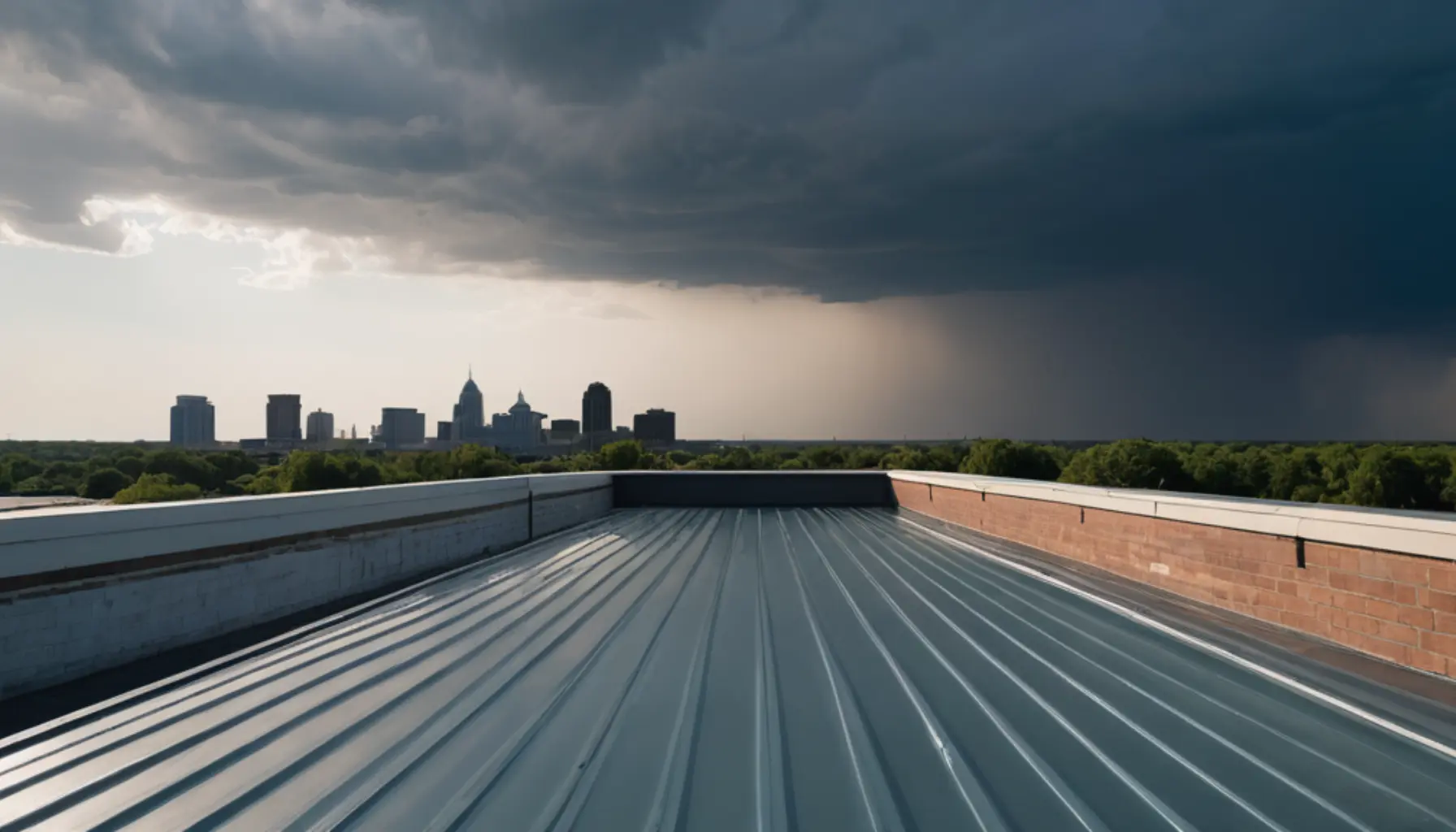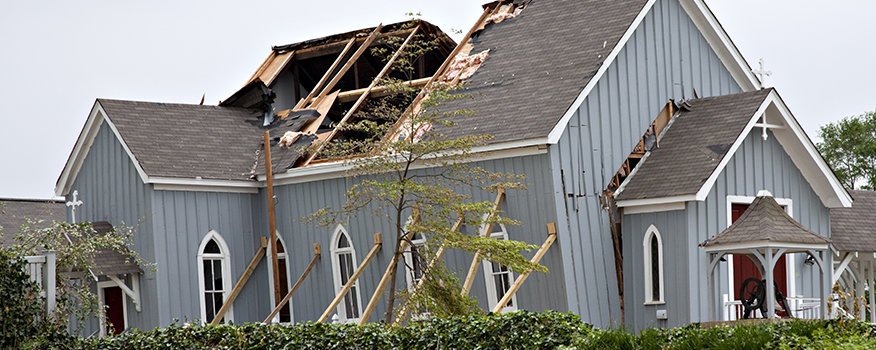Your roof is one of the most important parts of your commercial building. It protects everything inside, reduces energy costs, and saves you money on repairs. However, how long your roof lasts depends on the materials used and how well it handles Wichita’s challenging weather.
Wichita’s climate is tough on roofs. Summers are scorching, winters are freezing, and storms with hail and high winds are common. These conditions can wear out roofs quickly, especially if they’re not made of the right materials or aren’t properly maintained. Ignoring roof issues can lead to expensive repairs or even a full roof replacement sooner than expected.
In this article, we’ll explore the lifespans of common commercial roofing materials, explain how Wichita’s climate impacts them, and provide tips for making the best choice for your building. Solid Rock Commercial Roofing, a trusted local company, is here to help you find durable, long-lasting solutions designed specifically for Wichita’s unpredictable weather.
Key Takeaways:
- Wichita’s Climate is Tough on Roofs
- Hot summers, freezing winters, heavy rain, and frequent storms with hail and high winds make Wichita’s weather particularly hard on roofs.
- Extreme weather conditions can cause cracks, leaks, and premature aging of roofing materials.
- Roofing Lifespans Depend on Material and Maintenance
- Single-Ply Membranes (TPO, PVC, EPDM): Last 15–30 years but require maintenance to protect against UV damage and temperature changes.
- Modified Bitumen Roofing: Durable against storms but needs regular resealing to last its full lifespan of 10–20 years.
- Metal Roofing: Extremely durable, lasting 40–70 years, with maintenance to prevent rust and corrosion.
- Built-Up Roofing (BUR): Can last 20–30 years if properly maintained, but cold weather can cause cracking over time.
- Spray Polyurethane Foam (SPF) Roofing: Offers excellent insulation and lasts 20–30 years with regular re-coating.
- Green Roofing: Lasts 30–50 years but requires consistent upkeep to manage drainage and plant health.
- Factors That Affect Roof Lifespan
- Quality of Installation: Poor workmanship leads to early roof failure. A professional installation by experts like Solid Rock is crucial.
- Routine Maintenance: Regular inspections, cleaning, and repairs can add years to a roof’s lifespan.
- Storm Damage: Hail and windstorms can cause visible and hidden damage. Inspections after storms are essential.
- Building Codes: Adhering to Wichita-specific building regulations ensures roofs meet safety and durability standards.
- Environmental Conditions: Sun, rain, and freezing temperatures all contribute to the wear and tear of roofing materials.
- Choosing the Right Roofing Partner is Key
- Local roofing experts, like Solid Rock Commercial Roofing, understand Wichita’s climate and provide tailored solutions for long-lasting results.
- Investing in the right roofing materials and regular maintenance saves money in the long term by avoiding costly repairs or replacements.
- Protect Your Roof and Investment
- Proactively addressing roofing needs can extend its lifespan and protect your building.
- Call Solid Rock Commercial Roofing at (316) 227-2628 or visit https://solidrockcorp.com/ for a free consultation or inspection.
How Wichita’s Climate Impacts Roofs
Why Wichita Weather Is Tough on Roofs
Wichita’s climate puts commercial roofs through their paces. Here’s how:
- Hot Summers: Temperatures regularly exceed 90°F, and the intense sun breaks down materials over time. UV rays can cause roofing to fade, crack, or dry out.
- Cold Winters: Freezing temperatures, snow, and ice cause materials to expand and contract. Over time, this cycle leads to cracks and leaks.
- Storms and Hail: Tornadoes, hailstorms, and strong winds are common in Kansas, especially in spring and fall. These storms can cause immediate damage, like holes, tears, or even sections of the roof blowing off.
- Heavy Rain: Wichita gets plenty of rain, and without proper drainage, water pooling on a roof can cause leaks, mold, and structural damage.
How Climate Shortens Roof Lifespans
Wichita’s extreme weather can make roofs age faster. For example:
- UV rays can cause cracking and fading.
- Hail and high winds can lead to punctures and tears.
- Water damage can result in mold and rotting materials.
Choosing the right roof for these conditions is critical. That’s why partnering with local experts like Solid Rock Commercial Roofing can save you time, money, and headaches in the long run.
How Long Do Different Roofing Materials Last in Wichita?
Different roofing materials perform differently under Wichita’s tough climate. Let’s look at how long each type typically lasts and how it holds up.
1. Single-Ply Membranes (TPO, PVC, EPDM)
- Lifespan: 15–30 years, depending on maintenance and installation quality.
- Performance in Wichita:
- TPO (Thermoplastic Polyolefin): This heat-reflective material is great for summer energy efficiency, but it can crack without regular UV protection.
- PVC (Polyvinyl Chloride): PVC roofs resist chemicals and moisture but may become brittle during extremely cold winters.
- EPDM (Ethylene Propylene Diene Monomer): Known for its flexibility, EPDM handles freeze-thaw cycles well but requires UV-resistant coatings to prevent sun damage.
- Example: A warehouse with a TPO roof benefits from lower cooling costs in the summer. However, after 12 years, small cracks appear because the roof wasn’t maintained with protective coatings.
2. Modified Bitumen Roofing
- Lifespan: 10–20 years.
- Performance in Wichita:
- This roofing material does well in storms and handles hail impact better than many other options. However, extreme summer heat can soften it and speed up wear and tear.
- Regular resealing is necessary to prevent leaks.
- Example: A retail store with modified bitumen roofing survives several hailstorms but begins leaking after 15 years because pooling water wasn’t addressed.
3. Metal Roofing
- Lifespan: 40–70 years.
- Performance in Wichita:
- Metal is incredibly durable, standing up to hail, wind, and rain. Its reflective properties lower cooling costs during the summer.
- However, it needs a rust-resistant coating to prevent corrosion from moisture over time.
- Example: An office building installs a metal roof that holds up for 30 years without major issues. After three decades, a rust-resistant coating is applied to extend the roof’s life even further.
4. Built-Up Roofing (BUR)
- Lifespan: 20–30 years.
- Performance in Wichita:
- BUR roofs are strong against UV rays and hail, making them a good choice for Kansas weather. However, they can crack in freezing temperatures if not maintained properly.
- Example: A school with a BUR roof weathers multiple storms, but small cracks form after 25 years, requiring repairs to prevent leaks.
5. Spray Polyurethane Foam (SPF) Roofing
- Lifespan: 20–30 years with proper care.
- Performance in Wichita:
- SPF roofing offers excellent insulation, reducing heating and cooling costs. However, regular re-coating is required to protect it from UV damage.
- Example: A manufacturing plant installs SPF roofing and sees lower energy bills. Ten years later, the roof is re-coated to maintain its protective properties.
6. Green Roofing (Vegetative Roofs)
- Lifespan: 30–50 years with consistent upkeep.
- Performance in Wichita:
- Green roofs use plants to provide natural insulation and manage stormwater. However, Wichita’s extreme weather makes maintenance challenging. Poor drainage or overgrowth can shorten their lifespan.
- Example: An office complex installs a green roof that improves energy efficiency and reduces runoff. Regular maintenance keeps it functioning well, even during dry summers and wet winters.
What Factors Affect a Roof’s Lifespan?
Even the best roofing materials won’t last long if certain factors aren’t considered:
1. Quality Installation
Poor installation can lead to leaks, weak spots, and early failure. Choosing a trusted roofing company like Solid Rock ensures your roof is installed correctly the first time.
2. Regular Maintenance
Routine inspections can identify small issues—like cracks or blocked drains—before they become big problems. Regular maintenance, such as re-coating and patching, can add years to your roof’s lifespan.
3. Storm Damage
Kansas storms can cause visible damage like holes or tears, but they can also cause hidden damage. Scheduling inspections after storms can prevent further problems.
4. Building Codes
Wichita has specific building codes that affect roofing materials and installation methods. Solid Rock Commercial Roofing ensures your roof meets all local requirements.
5. Environmental Conditions
Extreme sun, cold, and moisture all affect how long your roof will last. Some materials, like metal or TPO, handle these challenges better than others.
Conclusion
Your roof is constantly working to protect your building from the elements, but Wichita’s weather takes a toll on even the toughest materials. The best way to ensure your roof lasts as long as possible is to choose materials designed for our climate and work with experienced local professionals like Solid Rock Commercial Roofing.
Don’t wait until your roof is damaged or worn out. Take action now to protect your business and save money in the long run. Call Solid Rock Commercial Roofing at (316) 227-2628 or visit https://solidrockcorp.com/ to schedule a free consultation or inspection.
With the right roofing solution and expert care, you can ensure your roof lasts for decades—keeping your building safe and your costs low. When it comes to commercial roofing in Wichita, Solid Rock is the name you can trust.
Frequently Asked Questions (FAQs)
How does Wichita’s climate affect my roof?
Wichita’s extreme weather, including hot summers, freezing winters, hailstorms, heavy rain, and high winds, can wear down roofs quickly. UV rays can cause materials to fade and crack, freezing temperatures can lead to expansion and contraction that creates leaks, and storms can cause punctures, tears, or even structural damage. Choosing the right materials and maintaining your roof is essential to protecting it from these conditions.
What type of roofing material lasts the longest?
Metal roofing has the longest lifespan, typically lasting 40–70 years with proper maintenance. It’s highly durable against Wichita’s hail, high winds, and extreme temperatures. Green roofs, which last 30–50 years, can also be very long-lasting if well-maintained.
How long does a single-ply membrane roof (TPO, PVC, or EPDM) last?
Single-ply membrane roofs can last anywhere from 15 to 30 years, depending on the type of material, the quality of installation, and regular maintenance. TPO is excellent for reflecting heat, PVC resists water and chemicals, and EPDM is flexible in cold weather. Each has unique benefits and vulnerabilities in Wichita’s climate.
How often should I have my commercial roof inspected?
It’s recommended to have your roof inspected at least twice a year—once in the spring and once in the fall. Additionally, inspections should be scheduled after severe storms to check for hidden damage, like hail impact or wind-related tears. Regular inspections help catch small problems before they become costly repairs.
What is the most storm-resistant roofing material?
Metal roofing is one of the most storm-resistant options, as it holds up well against hail and high winds. Modified bitumen and built-up roofing (BUR) are also good choices for storm-prone areas, as they are durable and resistant to impact damage.
What can I do to extend my roof’s lifespan in Wichita?
Here are a few tips to extend your roof’s lifespan:
- Work with a trusted roofing company, like Solid Rock Commercial Roofing, to ensure proper installation and upkeep.
- Schedule regular inspections and maintenance to catch issues early.
- Reapply protective coatings, such as UV-resistant or rust-inhibiting coatings, as needed.
- Clean gutters and drains to prevent water pooling on the roof.
- Repair small cracks, leaks, or tears immediately to avoid further damage.
Is it better to repair or replace a damaged roof?
This depends on the extent of the damage and the age of your roof. If the damage is minor and your roof is still within its expected lifespan, repairs are usually sufficient. However, if your roof is old, frequently damaged, or showing widespread wear, replacing it may be more cost-effective in the long run. A professional inspection can help you make the right decision.
Why is professional installation important for my roof’s lifespan?
Poor installation can lead to premature leaks, structural problems, and reduced lifespan, even with high-quality materials. Professional installers, like Solid Rock Commercial Roofing, ensure that your roof is installed correctly, meets local building codes, and is designed to handle Wichita’s weather challenges.
How do I know if my roof needs re-coating?
Signs that your roof may need re-coating include:
- Noticeable wear from UV exposure or storms.
- SPF, metal, and single-ply membrane roofs often require periodic re-coating to maintain their effectiveness and durability.
- Fading or peeling of the current coating.
- Increased energy bills (indicating reduced reflectivity).
- Small cracks or leaks beginning to form.
What is the cost difference between maintaining and replacing a roof?
Routine maintenance and repairs are far less expensive than replacing an entire roof. For example, fixing small leaks or applying protective coatings can extend your roof’s lifespan by years, saving you thousands of dollars. However, neglecting maintenance may lead to severe damage, requiring a costly replacement sooner than expected.
Can Solid Rock Commercial Roofing help with roof inspections?
Yes! Solid Rock Commercial Roofing provides free consultations and inspections. Our team will assess your roof’s condition, recommend the best solutions for your building, and ensure it’s ready to handle Wichita’s climate challenges. Call us at (316) 227-2628 or visit https://solidrockcorp.com/ to schedule your inspection today.
This article has been a collaboration between Rusty Cryer and OpenAI’s ChatGPT. Created on January 20, 2025, it combines AI-generated draft material with Cryer’s expert revision and oversight, ensuring accuracy and relevance while addressing any AI limitations.




